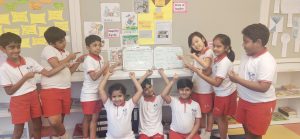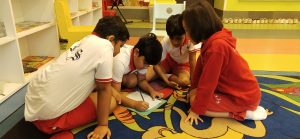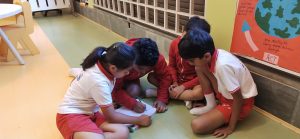This article explores the wonderful partnership created between Grade 3 learners and their home room teacher, as they confidently exhibited student agency throughout the unit of inquiry on child rights, under the transdisciplinary theme ‘Who we are’.
Grade 3 learners at Singapore International School, Mumbai took initiative, expressed their thoughts and ideas and made choices while planning and executing the unit ‘Who we are’, with the central idea: ‘Children are a part of the human society and have rights and responsibilities’.
It all started by reading a thought provoking story ‘Chuskit Goes to School’1 by Sujatha Padmanabhan together. This left the students with an understanding that every child has the right to education and can express their thoughts and wonderings to people around them. The students also watched a sensitive video2 in which a young group of children were seen working in the mines, drinking dirty water, getting infected and treated unfairly. After a brainstorming discussion, the students concluded that the unit is all about what children should be doing, what they should be privileged with and how they should be treated.
We did a ‘chalk talk’3 in the class and determined key words which helped us to figure out ‘rights’ and ‘responsibilities’. We went further and explored the transdisciplinary theme and other details of the unit. Learners were absolutely certain of going ahead and planning the inquiry. So, we started with the process.
To begin with, students brainstormed the big idea of the unit, kept the learning goals in mind and planned an assessment task. They worked on success criteria in groups, shared it with their peers and finally agreed upon a few, after considering the feedback.
I introduced my students to the ‘bubble planner’ which they co-constructed with much enthusiasm. They planned and created task sheets, assessments and learning engagements which included role plays, identifying their needs and wants and then comparing them with the less privileged children, reading of the rights mentioned in the UNCRC4, recognizing their personal responsibilities and the responsibilities of society, and so on. Every day the learners created a quote of the day based on the unit.
During this unit, we were scheduled to put up a class assembly for our primary division. Students promptly came up with the plan of enacting Chuskit and her story. They not only designed and directed the role play but also worked on making a PowerPoint presentation.
On the final day, I was a spectator myself as they delegated and distributed the required roles to each other. The assembly shared with the entire primary community was a proud moment for all of us.
English language was integrated through the unit and the students were exposed to the structure and requirements of writing an informal letter. They wrote exceptional letters to their friends within the class and outside the school, in which they expressed their feelings about less privileged children. Several action components were shared by them which included distributing leftover food from the school dining, teaching street children, and donating clothes, books and other basic necessities.
Towards the end of the unit, they created the end of unit reflection with a new concept of 5-4-3-2-1 strategy in which they framed questions for each number.
While I informed my students about the reflection that needed to be sent to the parents about the unit, they insisted on using their knowledge of letter writing and decided to draft a letter to their parents. They all worked together and crafted 4 different letters. We finally shared and extracted words and sentences from all the letters to publish one final letter. These students showed active involvement and gave thoughtful and meaningful considerations to every minute detail of the unit. They took responsibility for their learning, collaborated, planned and presented their understandings with confidence throughout the course of the unit.
‘We were fearless, We were confident, We tried and we succeeded, We hope to continue to believe in ourselves.’
This article has also been proof read by my young learners and they are extremely happy and proud that their learnings and experiences are going to be shared worldwide.
References:- Padmanabhan, Sujatha, and Madhuvanti Anantharajan. Chuskit Goes to School!: Inspired by True Instances in Villages of Ladakh. Pratham Books, 2011.
- Wanderer, Wise. “Your Smartphone Was Made By Child Slave Labor – Congo Cobalt Mines.” YouTube, YouTube, 15 July 2017, youtube.com/watch?v=I1nXa6t_9V0.
- Ritchhart, R., Church, M., & Morrison, K. (2011). Making thinking visible: How to promote engagement, understanding, and independence for all learners. San Francisco: Jossey-Bass.
(Pg 78 – 83) - “UN Convention On The Rights Of The Child.” Save the Children UK, www.savethechildren.org.uk/what-we-do/childrens-rights/united-nations-convention-of-the-rights-of-the-child.
Ms. Saloni Shah has been a Primary Division teacher for 13 years. Currently a Grade 3 Home Room Teacher at the Singapore International School, Mumbai, India, she is always keen to learn from her learners during the mentoring journey. In her 7 years of PYP teaching spanning three schools in the city, she has also worked as a Grade Level Leader.








This awesome
Its really amazing to see students being actively engaged and taking ownership of their learning.